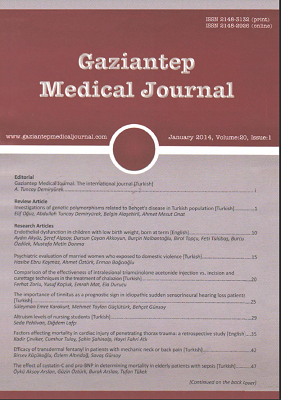Medication adherence in epilepsy and potential risk factors associated with non adherence in tertiary care teaching hospital in southwest Ethiopia
Epilepside tedavi uyumu ve güneybatı Etiyopya’daki üçüncü basamak eğitim hastanesinde tedaviye uyulmamasına bağlı potansiyel risk faktörleri
DOI:
https://doi.org/10.5455/GMJ-30-45904Keywords:
Adherence, antiepileptic drugs, JimmaAbstract
Medication non-adherence to antiepileptic medications is detrimental to the perceived outcome of treatment. Non-adherence to medication regimen accounts for substantial worsening of disease, death and increased health care costs. In this study, we aimed to determine adherence rate to antiepileptic medications and identify the potential risk factors associated with non-adherence in Jimma University Specialized Hospital/JUSH. A hospital based cross-sectional study was conducted on 265 patients using patients self report and pharmacy refill record. The self report involved the structured patient interview after verbal informed consent was obtained. Data were analyzed using SPSS for windows version 16.0. Chi-square test was used to observe the association of variables with adherence. The adherence rate of patients (n=265) to antiepileptic drugs/AED was found to be 63.2% based on their refill records, compliant fill rate. On the basis of patient’s self report for their pattern of drug use, 155 (58.5%) patients reported that they had never missed (neither daily dose nor time of taking), 78 (29.4%) missed daily dose some times, 12 (4.5%) missed only time of taking, and 7.5% (n=20) missed both time of taking and daily dose sometimes. The most common reasons for missing dose were forgetfulness (31.8%) followed by being busy (20.9%). Sedation (39.4%) was the commonest side effect faced by the patient. The rate of adherence absorbed in this study was low. Pill burden, co-morbid conditions and appointment missing were found to affect adherence. The high rate of non-adherence, in this study calls for further research and due consideration in planning appropriate strategies to improve the existing conditions.
Metrics
References
World health organization (WHO), Epilepsy, Fact sheet No 999,2012.http://www.who.int/mediacentre/factsheets/fs999/en/ (Accessed on 19 November 2013)
World health organization (WHO), Epilepsy care in the world, Atlas, 2005;20-24. http://www.who.int/mental_health/neurology/Epilepsy_atlas_r1.pdf (Accessed on 19 November 2013)
Chapman D, Panelli R, Hanna J. Jeffs T. Sudden unexpected death in epilepsy. Continuing the global conversation. Epilepsy Australia Ltd., Australia, 2011. http://www.sudepglobalconversation.com/files/sudden_unexpected_death_in_epilepsy_2011.pdf (Accessed on 19 November 2013)
Berhanu S, Prevett M. Treatment of epilepsy in rural Ethiopia: 2 year follow-up. Ethiop J Health Dev 2004;18(1):31-4.
Osterberg L, Blaschke T. Adherence to medication. N Engl J Med 2005;353(5):487-97.
World Health organization (WHO), Adherence to long-term therapies. Evidence for action. Geneva. 2003;87-93. http://www.who.int/chp/knowledge/publications/adherence_full_report.pdf (Accessed on 19 November 2013)
Eatock J, Baker GA. Managing patient adherence and quality of life in epilepsy. Neuropsychiatr Dis Treat 2007;3(1):117- 31.
Buck D, Jacoby A, Baker GA, Chadwick DW. Factors influencing compliance with antiepileptic drug regimes. Seizure 1997;6(2):87-93.
Coleman CI, Limone B, Sobieraj DM, Lee S, Roberts MS, Kaur R, et al. Dosing frequency and medication adherence in chronic disease. J Manag Care Pharm 2012;18(7):527-39.
Abula T, Worku A. Patient non-compliance with drug regimens for chronic diseases in northwest Ethiopia. Ethiop J Health Dev 2001;15(3):185-92.
Jones RM, Butler JA, Thomas VA, Peveler RC, Prevett M. Adherence to treatment in patients with epilepsy: associations with seizure control and illness beliefs. Seizure 2006;15(7):504-8.
Enríquez-Cáceres M, Soto-Santillana M. Non-compliance with pharmacological treatment in patients with epilepsy. Rev Neurol. 2006;42(11):647-54.
Wang WZ, Wu JZ, Ma GY, Dai XY, Yang B, Wang TP, et al. Efficacy assessment of phenobarbital in epilepsy: a large community-based intervention trial in rural China. Lancet Neurol 2006;5(1):46-52.
Faught E, Duh MS, Weiner JR, Guérin A, Cunnington MC. Nonadherence to antiepileptic drugs and increased mortality: findings from the RANSOM Study. Neurology 2008;71(20):1572-8.
Gomes Mda M, Maia Filho Hde S. Medication-taking behavior and drug self regulation in people with epilepsy. Arq Neuropsiquiatr 1998;56(4):714-9.
Javed N, Rehman AU, Saleem K, Siddiqui MA, Gill S.Perception about epilepsy among epileptic sufferers. Pakistan Journal of Medical and Health Sciences 2012;6(2):307-10.
Downloads
Published
How to Cite
Issue
Section
License
Copyright (c) 2023 European Journal of Therapeutics

This work is licensed under a Creative Commons Attribution-NonCommercial 4.0 International License.
The content of this journal is licensed under a Creative Commons Attribution-NonCommercial 4.0 International License.


















